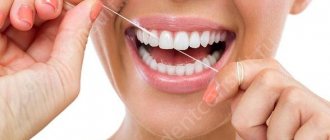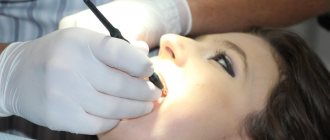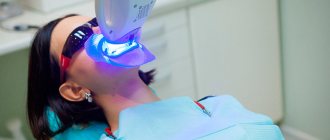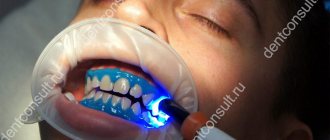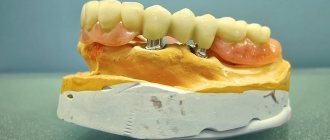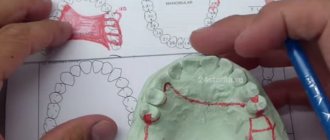Electrophoresis in dentistry is a physiotherapeutic procedure when medicinal substances are introduced into the body through electric current. This method uses special compounds that, under the influence of electricity, disintegrate into ions, accumulate in the pathological area and have a targeted effect on it. Thus, maximum therapeutic effect is achieved.
Indications for the use of electrophoresis in dentistry
- periodontitis;
- pulpitis;
- glossalgia;
- glossitis;
- purulent and inflammatory diseases of the oral cavity;
- dental cysts;
- dental granulomas;
- pathology of the facial nerve;
- inflammation of dental cells (alveolitis);
- lesions of the oral mucosa;
- severe pain after treatment or tooth extraction.
Despite the rapid development of technology in dentistry, electrophoresis has been and remains one of the most effective and affordable physiotherapeutic methods for treating hard and soft dental tissues.
Contraindications
Due to the peculiarities of the action of electric current, electrophoresis is not indicated for all patients; there are a number of restrictions on its use:
- Cardiovascular diseases in the stage of decompensation.
- Sclerosis of cerebral vessels.
- Bronchial asthma.
- Oncological diseases (in particular, neoplasms on the oral mucosa).
- Allergy to medications used for electrophoresis.
- Purulent-inflammatory processes accompanied by an increase in temperature above 38 °C.
- Systemic blood diseases.
- Bleeding or susceptibility to it.
- Epilepsy with frequent seizures.
- Presence of a pacemaker.
- Hypertension.
- Active phase of tuberculosis.
- Toxicoses.
- Cachexia.
- Psychosis and hysteria, accompanied by psychomotor agitation.
- Individual intolerance to electric current.
Features of electrophoresis for teeth
The procedure is performed in a treatment room and is comfortable and painless. Allows you to quickly relieve pain in the tissues, inside the dental canal, thereby eliminating foci of infection. Medicines are administered slowly, and the therapeutic effect lasts for several weeks. The risk of developing allergic reactions is minimal.
Medicines used in electrophoresis:
- lidocaine;
- iodine;
- vitamin cocktails;
- calcium;
- a nicotinic acid;
- novocaine, etc.
Purified water, dimexide, and buffer compounds are used as solvents.
Drug electrophoresis in dentistry is performed as follows:
- a special pad is wetted in the medicinal composition;
- the element is fixed at the site of inflammation;
- when treating pulpitis, the teeth are pre-treated and the drug is simultaneously injected into the canals;
- the tissues of the oral cavity are exposed to weak current pulses through the pad;
- The patient is given an electric current with a gradual increase in strength until painful sensations appear. Thus, the optimal indicator of the power of impact on the zone is determined;
- the procedure lasts about 10 – 30 minutes.
The average duration of an electrophoresis course is 10-20 procedures, which are performed daily or with breaks of one or two days.
Material and methods
The study involved 91 patients aged 18 to 65 years. All patients signed informed consent to conduct research. Treatment and examination were carried out in 91 teeth, of which in 48 (53%) teeth there were no periapical changes, and in 43 (47%) destructive changes in the periodontium were noted.
To determine the antimicrobial effect of various types of direct current exposure in vitro
used clinical strains of facultative anaerobic bacteria obtained from the root canals of teeth, namely:
Staphilococcus epidermidis
,
Streptococcus sanguis
,
Streptococcus mutans
,
Streptococcus salivarius
,
Candida krusei
,
Escherichia coli
,
Clostridium
spp.
For the cultivation of staphylococcus, streptococci and clostridia, 5% blood agar was used, E. coli - meat-peptone agar, and for Candida krusei
- Sabouraud's medium.
The study was carried out as follows: microbial cultures were inoculated onto the surface of freshly prepared agar in Petri dishes at a concentration of 1 million cells/ml (according to the optical turbidity standard) using the “lawn” method, evenly distributing them over the surface of the agar using a sterile spatula. Then the Petri dish was divided into sectors. In each sector, the antibacterial effect on a certain type of microorganism of a separate type of exposure to direct current was studied [7].
When studying apex phoresis, the active section of a silver-copper electrode connected to the positive pole of a current source was placed in the sector.
For anode galvanization, a single-core copper electrode was used, the active section of which was wrapped in a cotton swab with a diameter of 5 mm moistened with water. The electrode was connected to the positive pole of the current source.
When studying iodine electrophoresis, a single-core copper electrode was also placed in the sector, the active section of which was wrapped in a cotton ball with a diameter of 5 mm, moistened with a 10% solution of potassium iodide or a 10% solution of potassium iodide with the addition of 5% tincture of iodine, while the electrode was connected to the negative pole of the current source .
During depophoresis of copper-calcium hydroxide, a portion of copper-calcium hydroxide with a diameter of 5 mm was placed in the sector, in the center of which a metal electrode was placed, connected to the negative pole of the current source.
The exposure dose for apex phoresis was 5 mA x min, iodine electrophoresis and anode galvanization was 20 mA x min, and for depophoresis it was 5 mA x min.
During the study, one of the sectors served as a control. A test sample of an electrode or an electrode with a medicinal substance was placed in it, but the electrode itself was not connected to a current source (the action of passive diffusion).
After completing the procedure, the Petri dishes were placed in anaerostats with an oxygen-free gas mixture containing 80% nitrogen, 10% hydrogen, 10% carbon dioxide. The results were recorded after 7 days of incubation of Petri dishes in an anaerostat at 37 °C. The count was carried out by measuring the diameter of the zone of growth inhibition of bacterial colonies (in millimeters) around the hole left by the electrode on the agar. Depending on the diameter of the growth inhibition zone, the antibacterial effect was assessed as weak (with a diameter of less than 5 mm), medium (with a diameter of 5-10 mm) and high (with a diameter of more than 10 mm).
In order to study the influence of various types of transcanal direct current influences on the microflora of root canals in vivo
bacteriological examination was carried out twice - before and after the end of the course of electrical procedures (before filling the root canals).
Material was collected from the dental canals using a sterile paper absorber, which was then placed in a semi-liquid Ames nutrient medium. The nutrient medium was kept at a temperature of 2-4 °C before transportation. Transportation was carried out refrigerated for one hour.
Next, quantitative sectoral inoculation was carried out on media intended for cultivating oral bacteria under aerobic and anaerobic conditions. Pure cultures of obligate and facultative anaerobic bacteria were obtained under anaerobic conditions using 5% hemagar prepared on the basis of Brain-HeartInfusion with the addition of 5 mg/l hemin and 0.1 mg/l menadione, with the obligatory placement of the crops in anaerostats with oxygen-free gas a mixture containing 80% nitrogen, 10% hydrogen, 10% carbon dioxide. Using a complex of morphological, cultural and biochemical characteristics, the type of isolated bacteria was determined.
Biochemical identification of pure cultures of anaerobic bacteria, streptococci, staphylococci and gram-negative bacteria was carried out using test systems (France) and Roche (Germany).
Difficult-to-cultivate anaerobic bacteria were identified using the Multident-5 test system produced by Genlab LLC (RF), based on polymerase chain reaction (PCR). The technique was as follows: a sterile paper absorber was inserted into the root canal without contact with the mucous membrane, enamel surface and tooth crown; transferred the paper point into Eppendorf tubes and transported to the laboratory; DNA was isolated; PCR was performed; took into account the results of amplification of gel electrophoresis in 1.6% agarose [7, 8]. Samples taken from the root canals were delivered within 1 hour to the laboratory of the Department of Microbiology, Immunology and Virology of Moscow State Medical University, where PCR diagnostics were carried out. To isolate DNA, we used the method of accelerated sample preparation using a set of reagents for extracting DNA from clinical material (Genlab LLC). For DNA amplification of pathogenic bacteria Actinobacillus actinomycetecomitans
,
Prevotella intermedia
,
Bacteroides forsythus
,
Treponema denticola
,
Porphyromonas gingivalis
used the multiplex PCR method, which allows the simultaneous identification of several pathogens. The polymerase chain reaction was carried out in a thermal cycler of the Tertsik MS-2 brand, Moscow.
Competitive advantages of dental electrophoresis
- Painless
The procedure takes place in a comfortable environment. A slight tingling sensation is possible, but it is well tolerated by both young and adult organisms.
- Efficiency
You will feel a positive result after the first session. Inflammatory processes inside the dental canal, as well as in the tissues surrounding the apex, are quickly relieved. After the procedure, regeneration processes in the body are noticeably activated.
- Spot impact
Thanks to the procedure, the medicine gets directly into the pathological focus: dental pulp, dentin, dental canal, enamel tissue, periodontium (in case of obstruction of the root canals). This technique is much more effective than the usual use of drugs.
- Minimal risk
The procedure is completely safe, has a minimum of restrictions, and does not cause irritation inside or outside the tissue. The maximum that can happen is slight redness after the procedure, which will go away in 30 minutes.
- Cumulative effect
Positive changes occur with a cumulative effect. Ion exchange inside cells is improved, microcirculation in cell membranes improves. Electrophoresis can effectively restore tooth enamel, improve blood supply to teeth, and remove and treat inflammation.
At the Zuub.rf clinic you can take a course of dental electrophoresis using modern equipment. The specialist will select the most effective composition of medications and, in a few sessions, will help solve a specific problem with the soft and hard tissues of the oral cavity.
If you have the symptoms described in this article, be sure to make an appointment at our clinic.
Don't self-medicate! Even the smallest problem, if not treated correctly, can significantly complicate your life.
By contacting us, you can be sure that:
- Get high-quality and free consultation .
- You will receive the best prices for treatment and the opportunity to receive a special promotional price.
- Only modern equipment and materials will be used.
- You will be treated by professional doctors with many years of experience.
- We offer treatment on credit or in installments. There is also the possibility of obtaining a tax deduction.
- We work seven days a week and without a lunch break, from 9 a.m. to 10 p.m.
+7 (495) 132-02-96
Make an appointment
Price
The cost of electrophoresis in private and public clinics depends on the type of equipment, medications used, and payment terms for doctors used in the clinic.
In the price list of organizations, the name “electrophoresis” may mean a different set of procedures and services, so the stated prices may vary greatly.
Electrophoresis itself, excluding medications, is usually inexpensive - from 100 to several hundred rubles per session.
If inexpensive medications are used, in particular, calcium gluconate, the purchase of which for the entire course will require from 100 to 200 rubles, then the price of the entire remineralization course will cost a little more than 1000 rubles.
In the price lists of various dental companies you can see the following prices for one session of various types of electrophoresis.
- Transchannel – 1000 rub.
- Depophoresis of one root canal – from 250 to 500 rubles.
- Electrophoresis of dentin and gums – 400-500 rubles.
Advice. The given data can only serve as a guide; prices in specific conditions may differ significantly from them. When deciding on electrophoresis, you must definitely clarify for how many sessions the price is indicated, and whether the cost of medications is included in it.
Reviews
Reviews from patients about a particular treatment procedure are often superior in their benefits to official information.
People are interested in knowing the personal impressions and feelings experienced by a person in their position.
If you have already used electrophoresis for dental treatment, share your impressions with those who have yet to do so. Leave your review at the bottom of the page.
If you find an error, please select a piece of text and press Ctrl+Enter.
Tags toothache electrophoresis for teeth
Did you like the article? stay tuned
